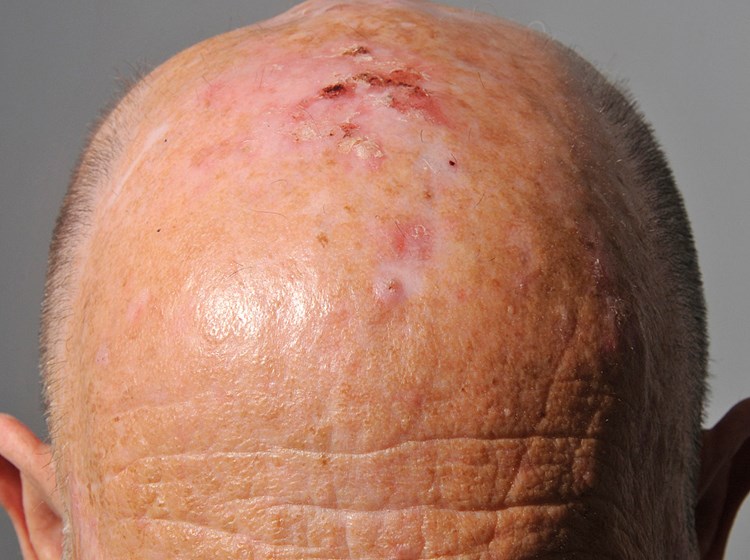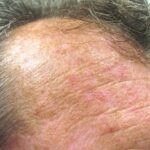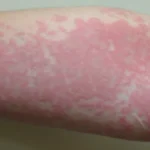Actinic keratosis (AK) is a common skin condition caused by prolonged exposure to ultraviolet (UV) radiation, primarily affecting sun-exposed areas. When actinic keratosis occurs on the trunk or extremities, it can pose unique diagnostic and management challenges. This guide explores the causes, symptoms, diagnostic methods, and treatment options for AK on these regions, providing actionable insights for patients and healthcare professionals.

What is Actinic Keratosis?
Actinic keratosis is a precancerous skin lesion that arises due to cumulative sun damage. It manifests as rough, scaly patches or plaques and has the potential to progress into squamous cell carcinoma (SCC) if left untreated. While AK is most frequently observed on areas with high sun exposure, such as the face and scalp, it can also develop on the trunk and extremities, especially in individuals with prolonged outdoor exposure or tanning practices.
Causes of Actinic Keratosis on the Trunk or Extremities
The primary cause of AK is UV radiation from sunlight or artificial sources such as tanning beds. On the trunk and extremities, additional contributing factors include:
- Cumulative Sun Exposure: Repeated UV damage over time weakens the skin’s repair mechanisms.
- Skin Type: Fair-skinned individuals are more prone to developing AK due to lower melanin levels.
- Clothing Gaps: Areas inadequately protected by clothing may be more susceptible to UV damage.
- Age: AK prevalence increases with age as UV damage accumulates over decades.
Recognizing Symptoms of Actinic Keratosis on the Trunk or Extremities
Actinic keratosis can present differently depending on the affected area. Key characteristics include:
- Texture: Rough, sandpaper-like patches that are often easier to feel than see.
- Color: Lesions may appear red, pink, or skin-colored and can sometimes develop a whitish scale.
- Size and Shape: Patches can range from a few millimeters to several centimeters, with irregular borders.
- Location: On the trunk, AK often develops on the back or shoulders, while on the extremities, it may affect the arms, legs, or hands.
Diagnosing Actinic Keratosis on the Trunk or Extremities
Clinical Examination
A dermatologist typically identifies AK through visual and tactile examination. Dermoscopy can be used to magnify and analyze lesion patterns, helping to distinguish AK from other skin conditions like eczema or psoriasis.
Skin Biopsy
In cases where AK may mimic skin cancer or display atypical features, a skin biopsy is performed to confirm the diagnosis and rule out malignancy.
Treatment Options for Actinic Keratosis on the Trunk or Extremities
Timely and effective treatment is crucial to prevent the progression of AK into SCC. Treatment modalities include:
1. Topical Therapies
- 5-Fluorouracil (5-FU): A widely used topical cream that targets abnormal skin cells while sparing healthy tissue.
- Imiquimod: Stimulates the immune system to destroy precancerous cells.
- Diclofenac: An anti-inflammatory gel suitable for patients with multiple lesions.
2. Cryotherapy
Cryotherapy involves freezing the lesion with liquid nitrogen, effectively destroying abnormal cells. This is particularly effective for isolated lesions but may not be ideal for extensive AK.
3. Photodynamic Therapy (PDT)
PDT combines a photosensitizing agent with light exposure to selectively destroy damaged cells. It is commonly used for widespread lesions and has excellent cosmetic outcomes.
4. Surgical Excision
Surgical removal may be necessary for persistent or suspicious lesions, ensuring complete excision and histological analysis.
Preventing Actinic Keratosis on the Trunk or Extremities
Prevention plays a vital role in reducing AK incidence and recurrence. Strategies include:
- Sun Protection: Use broad-spectrum sunscreen (SPF 30+), wear UV-blocking clothing, and seek shade during peak sunlight hours.
- Regular Skin Checks: Perform monthly self-examinations and schedule yearly dermatologist visits for early detection.
- Avoid Tanning Beds: Artificial UV exposure is a significant risk factor for AK development.
Actinic keratosis on the trunk or extremities requires prompt diagnosis and treatment to mitigate its potential progression into skin cancer. By adopting preventive measures and adhering to recommended treatments, individuals can effectively manage this condition and maintain healthy skin. Regular dermatological care remains essential for long-term outcomes.

